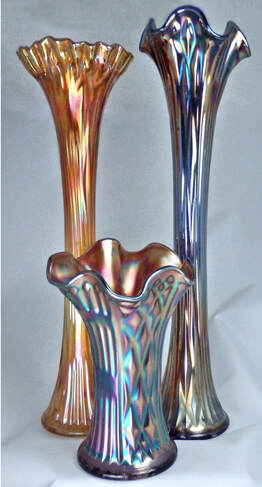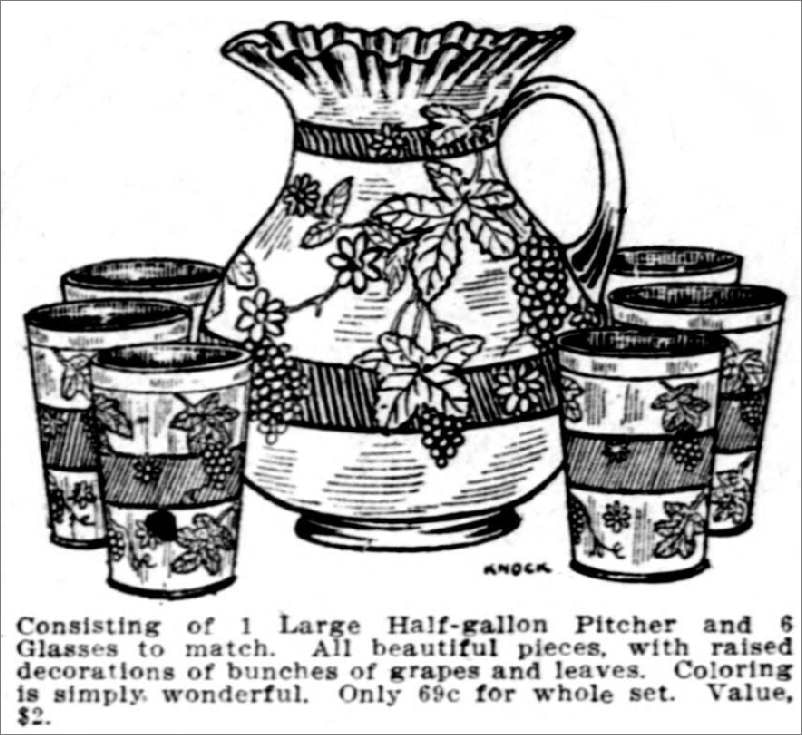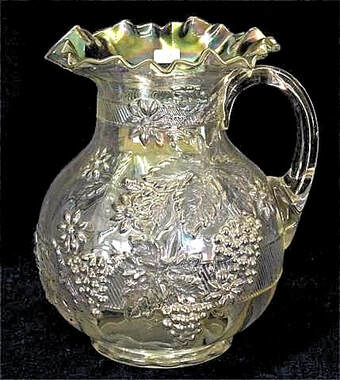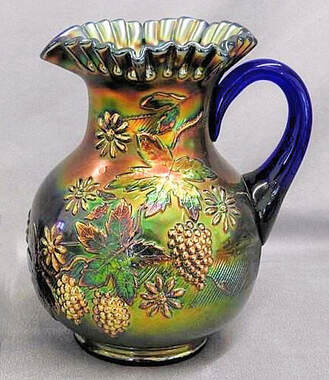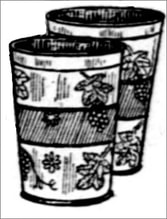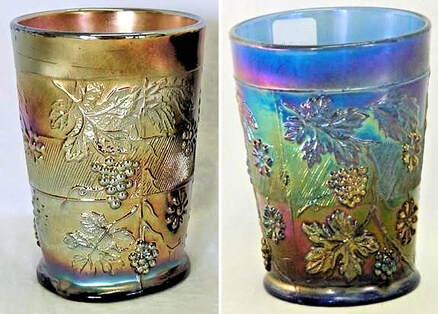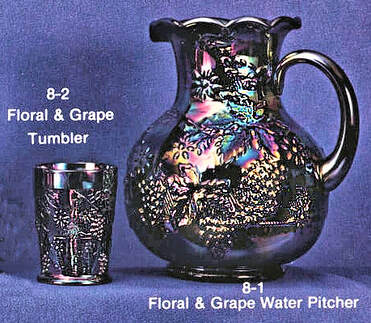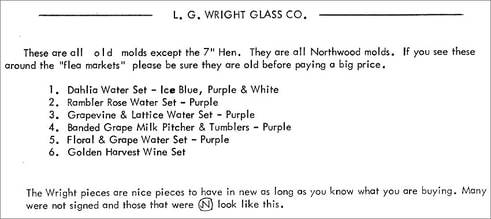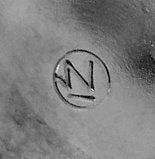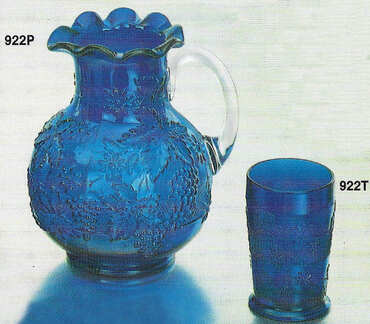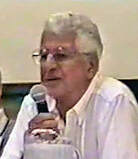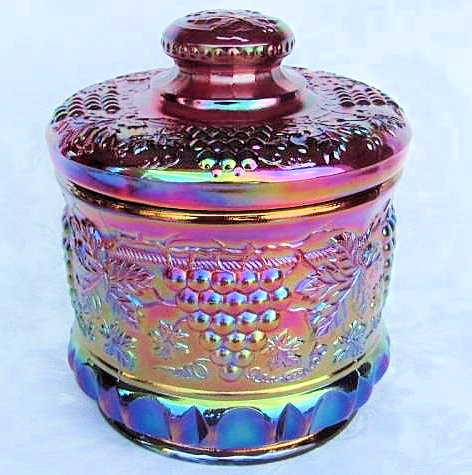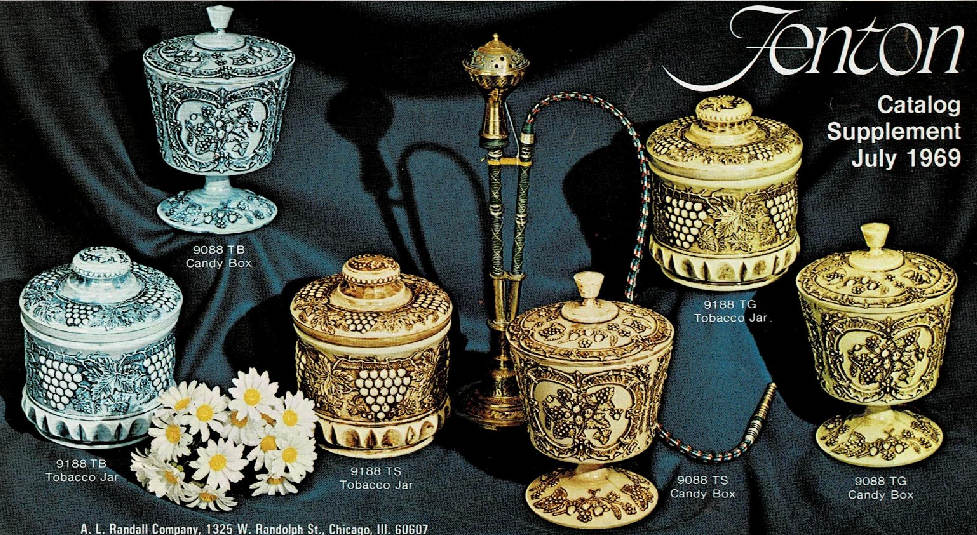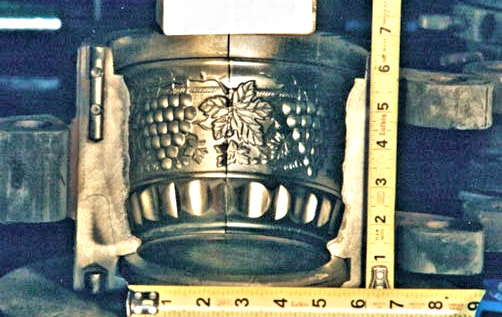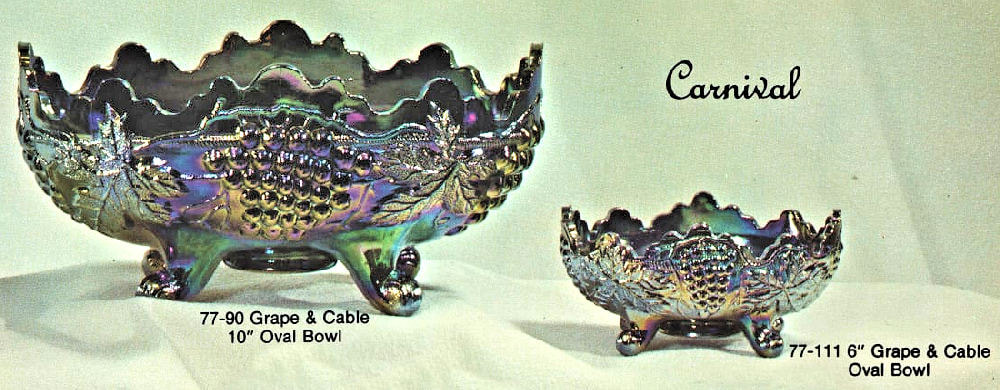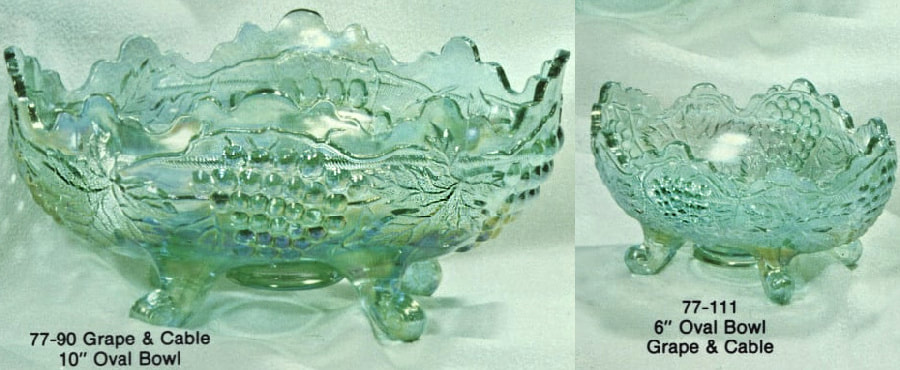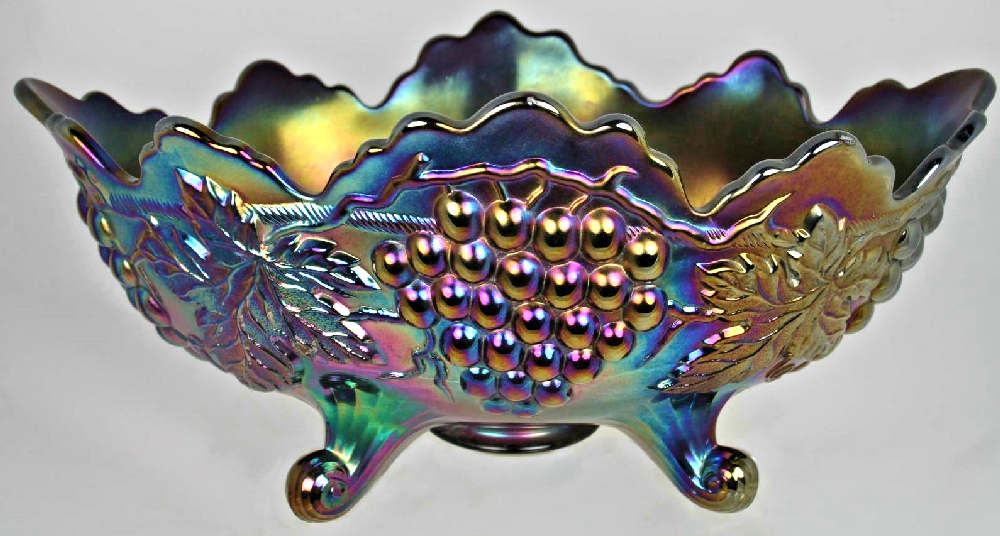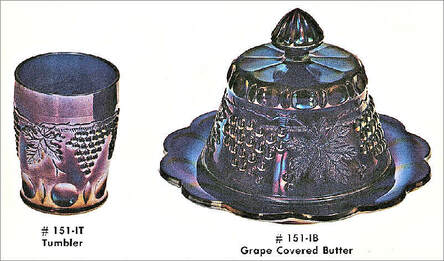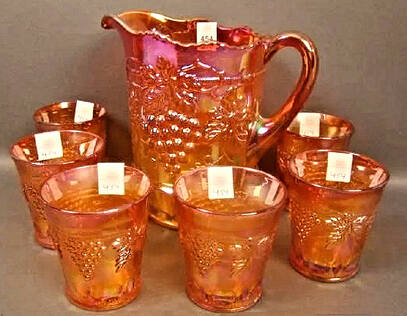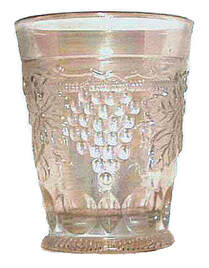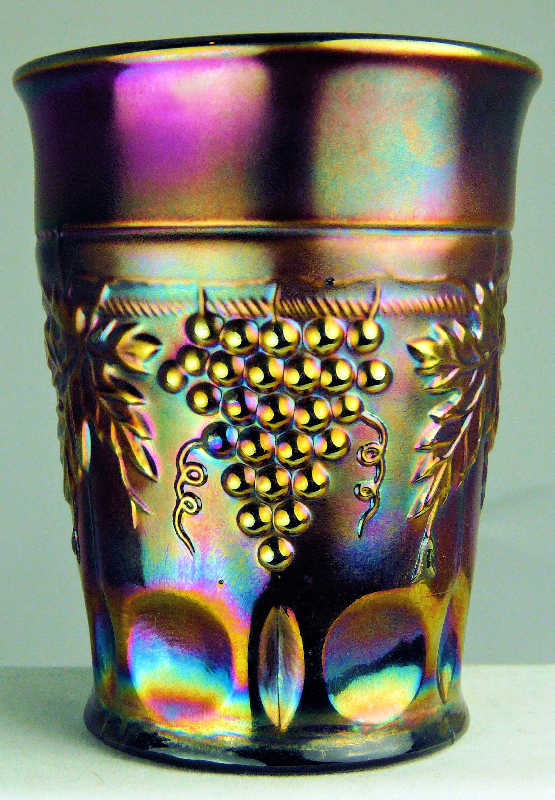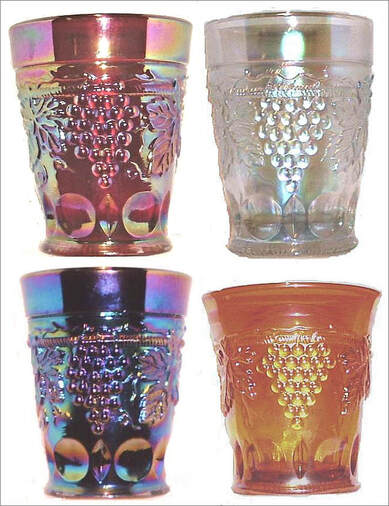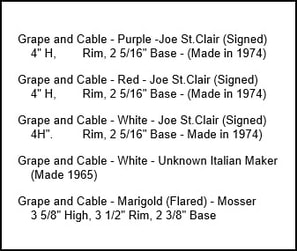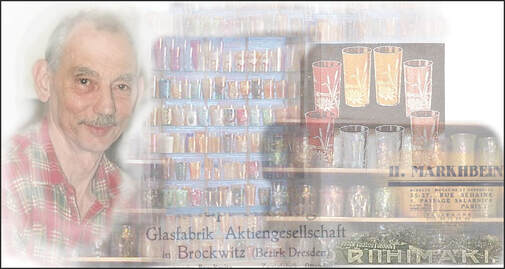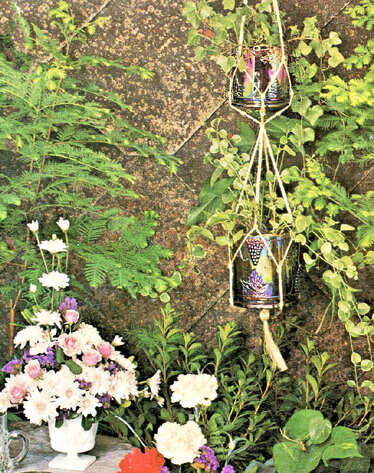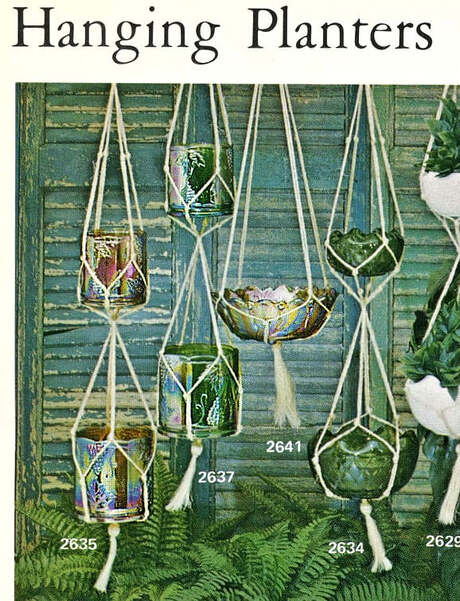NetworK ezine Issue 85. June 2022
Totally Devoted to Carnival Glass
|
Making a Swung Vase
On the right is a trio of vases in three heights - they are all Fenton's #916 (aka Nine Sixteen, aka Spearhead and Ribs, aka Spearhead and Diamonds). The short vase in the centre was only swung a little, up to just 7 inches, and so the moulded pattern can still be clearly seen on it. The other two vases were swung much more, attaining heights of 15.5 inches and 17 inches. Note how the pattern has been stretched out to the point of being almost unrecognisable. The diameter of the base of all three vases is the same, as they were all made from the same mould. A picture is worth a thousand words!
More videos are being worked on, and will be added soon. Follow this link to see Howard's wonderful swung vase video (and other videos in the series): Howard Seufer Presents |
Fenton's Nine Sixteen (aka #916) vases
|
What is a Swung Vase?
Vase moulds are relatively short and stubby in height (generally around four to six or seven inches). When the hot vase was taken out of the mould, the base was held in a tool called a snap, and the vase was then reheated in the glory hole, so that the glass would become elastic and malleable. Whilst still hot, the glassmaker would then swing the vase, stretching it out to its intended finished height. The final height would depend on various factors, such as the temperature and elasticity of the glass, and the swinging effort applied by the glassmaker. *
The term “swung vase” refers to the swinging motion used by the glassmaker – and it’s hard to imagine this fascinating process. But now you can see it for yourself, in Howard’s video clip. Watch as a short vase gets longer and longer with each swing! It’s not a new term – it was used in the early days of Classic Carnival production, alongside a similar term “swung out”.
* Note: the classification size of a swung vase is determined by its base diameter, not its height.
What is a Swung Vase?
Vase moulds are relatively short and stubby in height (generally around four to six or seven inches). When the hot vase was taken out of the mould, the base was held in a tool called a snap, and the vase was then reheated in the glory hole, so that the glass would become elastic and malleable. Whilst still hot, the glassmaker would then swing the vase, stretching it out to its intended finished height. The final height would depend on various factors, such as the temperature and elasticity of the glass, and the swinging effort applied by the glassmaker. *
The term “swung vase” refers to the swinging motion used by the glassmaker – and it’s hard to imagine this fascinating process. But now you can see it for yourself, in Howard’s video clip. Watch as a short vase gets longer and longer with each swing! It’s not a new term – it was used in the early days of Classic Carnival production, alongside a similar term “swung out”.
* Note: the classification size of a swung vase is determined by its base diameter, not its height.
|
We also have two very informative articles about swung vases - the first one is by Carnival Glass vase expert, Joan Doty. Here are the two links: |
Imperial Catalog 100A (c. 1913).
|
|
Floral and Grape - The Enigma Unwrapped
The Floral and Grape water set constantly presents a challenge regarding attribution, and often appears in our NetworK Facebook group. It was made by both Fenton and Dugan-Diamond, but here’s the real challenge, it was also reproduced in Revival Carnival by two more glass makers. If you had all the various makers’ examples in front of you, it might be reasonably easy to sort them out – but if you only have one example, well, then it gets tricky. Here we aim to offer you easy ways to spot the differences – and you won’t have to work your way through several pages of measurements and intricate details to do it! Classic Old Versions Pitcher Both Dugan-Diamond and Fenton made Floral and Grape in a water set (pitcher and tumblers). There are many subtle differences, but the easiest way to pin down the pitcher is to look at the bands of slanting lines – they lean to the left \\\ on the Dugan version and they lean to the right /// on the Fenton version. Additionally, there are clear horizontal lines above and below the bands of slanting lines on the Dugan-Diamond pitcher. On the right is a 1912 drawing in an ad in the Washington Herald, shows the Dugan-Diamond version very clearly. The left leaning lines \\\ on the pitcher and the clearly defined edges to the encircling bands, are perfectly illustrated. There is a very scarce version of the pitcher with no slanting lines at all – it’s Fenton’s. |
Above: this 1912 drawing in an ad in the Washington Herald, shows the Dugan-Diamond version very clearly.
|
Another “tell” for the tumblers is most interesting and it involves the mould lines. Look at the two tumblers above again. On the blue Fenton one you should be able to easily see the vertical mould line running from near the top to the bottom. Note how the line is clear and the leaves and grapes don’t cover it. But on the amethyst Dugan-Diamond tumbler it’s another story altogether! The grape bunches and the tendrils cross over the mould seams, in fact the vine seems to tangle itself over that mould line, and at the bottom you can actually see that the grape bunch covers the vertical mould seam as well. |
Above, left: an amethyst Dugan-Diamond tumbler (courtesy Burns Auction Service) with a clearly defined lines above and below that encircling band of slanted lines, and right, a blue Fenton version (courtesy Seeck Auctions), which does not have that clearly defined line.
|
Reproductions
Westmoreland for L.G. Wright. In the 1970s, L. G. Wright had the Floral and Grape pitcher and tumbler made for them in amethyst/purple Carnival by Westmoreland using the original old Dugan-Diamond moulds, and even using the name that had been given to this pattern by Carnival collectors. At the time it was generally believed that those “old moulds” were Northwood’s – this was before the early 1980s revelation that Dugan-Diamond had been responsible for many iconic items that were previously believed to be made by Northwood.
|
Above: Reproduction pitcher and tumbler made by Westmoreland for L. G. Wright – as shown in Wright’s 1978 catalogue. Courtesy of Glass Paper Fanatics.
|
|
These L. G. Wright items were made from the original Dugan-Diamond moulds, so they have the \\\ slanting lines and the clearly defined edges to that encircling band (meaning that the pitchers can’t be mistaken for old Fenton ones).
So, how can the collector distinguish between the Classic old Dugan pitchers and the reproduction Wright version? First, check the base to see if there is a wonky N mark! (Some repros have the mark, but not all repros do!) Next, look at the handle on the pitchers. The Classic old ones had applied handles that were not iridised (i.e. the handle was applied after the item had been sprayed with iridescence). The reproduction pitchers have applied handles that are usually fully iridised (i.e. the handle was applied before spraying, and thus is iridised as well as the rest of the pitcher).
What about the purple L.G. Wright tumblers? Obviously, no handles to look at! Some of them will be marked with the wonky N, and if there’s any trace of iridescence on the base (underneath) then it’s almost certainly a newer reproduction.
Mosser. The Floral and Grape pitcher and tumbler were made by Mosser from at least as early as 1994, being itemised in their Retail Price List for that year.
|
Our investigation has revealed that the pitcher is almost certainly made from the original Dugan-Diamond moulds, obtained from L. G. Wright. However, the Mosser tumbler is different – it’s larger than the originals (a full inch taller at 5” high, compared to the 4” Dugan-Diamond/Wright versions) which makes it easy to spot. We undertook a little detective work to get to the bottom of this mystery. In 1998, all the moulds then at L.G. Wright were sold at a well-publicised mammoth auction. The results and the companies that bought the moulds are also known. Two Floral and Grape tumblers were sold – one went to Castle/AA Importing and the other was bought by Mosser. However, note that this was in 1998. But the Floral and Grape pitcher and tumbler have been featured in Mosser catalogues since at least 1994. So, what happened? It would appear that several years before the big Wright 1998 sale (probably early 1990s), Mosser purchased (or leased) from Wright, the Floral and Grape pitcher mould, as well as the Dahlia pitcher and some Grape and Cable moulds. It appears that Mosser didn’t get the Floral and Grape tumbler mould at that time, and so they made a new mould, which accounts for the much larger size. A tumbler mould was subsequently purchased by Mosser in 1998, but it looks like they haven’t yet used it, as the large version is still in circulation. Mosser have also made the Floral and Grape pattern in Carnival; we have seen examples in purple, and also in Mosser’s marigold (which is a vibrant orange colour with a reddish iridescence). The handles on the pitchers are iridised and we have seen some examples that have been beautifully twisted. The tops of the pitchers may also have some kind of hand-shaping. Some examples carry a moulded M on the base. |
A Mosser Floral and Grape pitcher and tumbler in non-iridised blue with a clear crystal handle,
as it was shown in their 1994 Retail Price List. Sometimes it is referred to as Grape and Floral. |
|
For further reading, we have two related articles: |
The Dugan Dig: NetworK Issue #77 |
Grape and Cable Revived
Both Northwood and Fenton made the iconic and ever-popular Grape and Cable pattern in Classic Carnival. Northwood produced it in a very wide range of shapes, while Fenton produced only plates and bowls (in several sizes). There are usually certain characteristics that enable collectors to distinguish between the two makers fairly easily, although sometimes it’s a little more of a challenge. We have a comprehensive guide to this in the form of a free eBook (downloadable PDF) which will enable you to easily figure out the makers (we’ll add the link at the end of this section for you).
What we will be looking at in this issue of NetworK, however, are some of the Revival versions of the Grape and Cable pattern.
Both Northwood and Fenton made the iconic and ever-popular Grape and Cable pattern in Classic Carnival. Northwood produced it in a very wide range of shapes, while Fenton produced only plates and bowls (in several sizes). There are usually certain characteristics that enable collectors to distinguish between the two makers fairly easily, although sometimes it’s a little more of a challenge. We have a comprehensive guide to this in the form of a free eBook (downloadable PDF) which will enable you to easily figure out the makers (we’ll add the link at the end of this section for you).
What we will be looking at in this issue of NetworK, however, are some of the Revival versions of the Grape and Cable pattern.
|
Making a New Mould The Grape and Cable tobacco jar was made in purple Carnival for Rose Presznick in 1969. A new mould was made for it, modelled on an old Northwood Grape and Cable humidor. In 1968 Rose Presznick had asked Frank Fenton to reintroduce Carnival Glass into the Fenton line, and chose a Grape and Cable tobacco jar (humidor).
would work, but I got a copy or reproduction of it in reverse and then I designed a mould to fit it. Then I duplicated from the epoxy into the mould and ended up with a beautiful repro of the tobacco jar. It was the first time I had tried that and it was one of my favourite pieces.”
The actual mould made by Carnick at Fenton is shown below, right. |
Red Grape and Cable Tobacco Jar in Revival era Carnival made by Fenton. Courtesy Burns Auctions.
|
|
The new Carnival version was made for the Presznick Museum in 1969, and it has a special base plate with the date and Presznick Museum wording on it. Also in 1969, Fenton catalogues show that other non-Carnival glass colours were used for the humidor. Later, Fenton produced the Grape and Cable humidor in other Carnival colours, including marigold on ruby, spruce green and favrene, describing it as an “authentic reproduction”.
|
Above: Fenton's new mould for the Grape and Cable tobacco jar.
Courtesy of the Fenton Family and Fenton Art Glass Company. Left: a 1969 Fenton Catalog Supplement extract, produced for A. L. Randall Co. (Chicago) – primarily for the florist trade. |
This Supplement selection was called “Wild Strawberries and Grapes” and was described as “A new hand rubbed finish to accent the beautifully detailed pattern of these handsome decorator pieces. A unique treatment for two unusual covered jars”. Courtesy Jon D. Bartell and the Glass Paper Fanatics.
More New Moulds
Also in the 1960s, Al Botson made two new moulds for L. G. Wright, based on the iconic Northwood Grape and Cable banana boat. In 1964, the mould was made for the large 10” oval bowl (banana boat; the 6” oval bowl mould was made in 1969. Both were made in Carnival for Wright (purple and ice green).
More New Moulds
Also in the 1960s, Al Botson made two new moulds for L. G. Wright, based on the iconic Northwood Grape and Cable banana boat. In 1964, the mould was made for the large 10” oval bowl (banana boat; the 6” oval bowl mould was made in 1969. Both were made in Carnival for Wright (purple and ice green).
Even More New Moulds
In 1976, a tumbler and butter dish appeared in Mosser’s catalogue, shown in cobalt blue Carnival. The pattern was called “Grape”. After the millennium, Mosser began to use the “Grape and Cable” name instead. Again, these were new moulds (the original Northwood Grape and Cable butter has a saw-tooth edge, not scalloped like the Mosser version).
In 1976, a tumbler and butter dish appeared in Mosser’s catalogue, shown in cobalt blue Carnival. The pattern was called “Grape”. After the millennium, Mosser began to use the “Grape and Cable” name instead. Again, these were new moulds (the original Northwood Grape and Cable butter has a saw-tooth edge, not scalloped like the Mosser version).
|
Other new shapes (also from new moulds) have been added to the full size Mosser “Grape and Cable” line, some of which are known in Carnival, including a rather bright “marigold” that is distinguished by a red appearance (shown, right). A smaller selection of miniature sized pieces was also made. Cut from Mosser Glass catalogue, 1976.
Courtesy Glass Paper Fanatics. |
Mosser “marigold” Grape and Cable water set, courtesy Burns Auction Service. The Mosser tumblers are a little smaller than the Northwood or St Clair versions, standing 3⅝” high. These are sometimes marked with Mosser’s trademark.
|
Cut from Mosser’s 2003 catalogue showing the wide range of shapes
in their Grape and Cable line. Courtesy Glass Paper Fanatics.
in their Grape and Cable line. Courtesy Glass Paper Fanatics.
Mosser also made a miniature 3-piece Grape and Cable table set. We revealed their catalogue image of this set in NetworK #94.
|
The Grape and Cable tumbler is an interesting item in itself and deserves a special mention.
Firstly, for comparison, on the right is a regular Northwood old, Classic tumbler (N marked). It stands 4” high – the larger (king-size or tankard version) stands 4¼” high. Back in 1965, a reproduction (also referred to as a fake) Grape and Cable tumbler was reported.
|
Above: a Classic old Northwood Grape and Cable tumbler in purple. N marked.
|
|
Courtesy of the late Bob Smith, we take pleasure in honouring his memory and passion for both tumblers and education, by sharing some more of his photos of these tumblers.
The Grape and Cable tumblers above are, clockwise from the top left:
St. Clair, red; St. Clair, white; Mosser, marigold: St. Clair, purple. |
Above: Bob kept a phenomenal archive of all his thousands of tumblers. Here is an actual extract (screen shot) from one of his hundreds of emails sent to us – this one gives the information about these tumblers
|
Bob was a long-time dedicated researcher and collector – devoted to his extensive, comprehensive tumbler collection. It covered all eras of Carnival, and all makers. As an educational resource for posterity, his dearest wish was to keep the entire collection intact; never to be sold or broken up. In 2011 Bob bequeathed his entire collection to Glen, re-affirming his wishes in 2016, when he wrote to Glen “you are the owner now” (of the Bob Smith Tumbler Collection). We committed to Bob that the collection would never be sold or broken up.
Sadly, Bob passed away in November 2017, but he was comforted by the knowledge that he had taken steps to entrust the ownership and the guardianship of his unique collection, and to preserve the legacy intact for future generations of collectors and researchers. Bob trusted and believed that his legacy collection would stay intact and whole – and it was our intention to honour that. However, in distressing circumstances completely beyond our power or control, Bob's tumbler collection was removed from our protection. Subsequently it was broken up, fragmented and sold in June 2019.
The Bob Smith Legacy Collection was no more. The unique opportunity for Carnival collectors of today and tomorrow, to learn from Bob’s “Century of Tumblers” together in one heritage collection, was irrevocably destroyed. We are determined to keep his story and his memory alive.
It is very appropriate at this time, close as we are to Memorial Day, to remember and reflect on our dear friend, Bob Smith and the sad fate of his unique tumbler collection. Read all about Bob’s unique tumbler collection here: Bob Smith's Tumbler Museum.
Here is the link to our free eBooks including the Grape and Cable eBook: Carnival Glass eBooks
|
Indiana Surprise!
Who knew? In Indiana’s 1975-1976 Florist Selection Catalogue, they took some Harvest Carnival candy jar / cannisters (minus lids) and the Iridescent Gold Wild Rose console bowl and turned them into hanging planters with the judicious addition of rope suspension. WOW! A clever example of multi-purpose selling. Indiana clearly found the novelty appealing enough to feature it on the cover of their 1975-1976 Florist Selection Catalogue, too. |
Item 2635 comprised two sizes of the Iridescent Blue Harvest jar bases, item 2637 comprised two sizes of the Iridescent Lime (green) Harvest jar bases and item 2641 was the Iridescent Gold Wild Rose bowl.
|
Extracts from 1975-1976 Florist Selection Catalogue from Indiana Glass. Grateful thanks to and courtesy of Craig Schenning. Also, our thanks to the Dunkirk Museum and the Glass Paper Fanatics.
If you have missed any of the previous issues of NetworK and NetworK Specials, they are all here: Back Issues.
Privacy and the use of your information: we only use your name and email address to send you your FREE Carnival Glass NetworK ezine. We will not share your name or email address with anyone else, or use it for any other purpose. You can change your mind about receiving your NetworK ezine at any time by clicking the unsubscribe link at the foot of every issue, or by emailing us at [email protected]
Join us on Facebook
We would love you to come and join in the fun, and we invite you and your friends to join us all on NetworK's fast growing and very active Facebook Group!
We would love you to come and join in the fun, and we invite you and your friends to join us all on NetworK's fast growing and very active Facebook Group!


